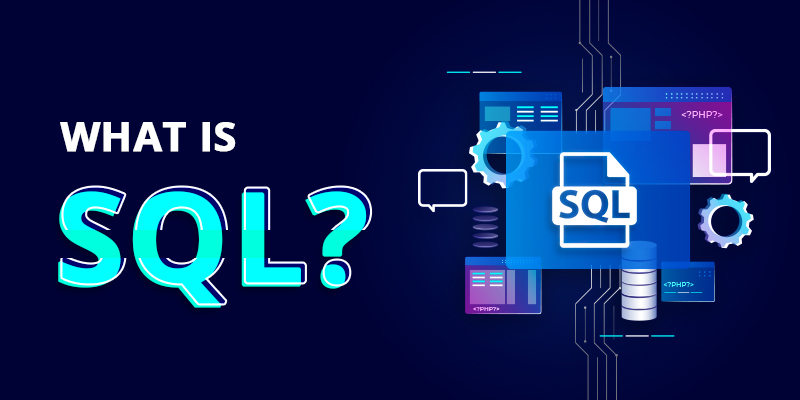What is SQL?: Structured Query Language Guide
Structured Query Language or simply SQL is a language used to communicate with Databases. If you want to pull, edit, or add information to a database, you can use SQL to do that. Numerous additional tasks, such as database management and optimization is also possible using SQL. If you wish to start your professional journey in the same, SQL certification course is something you can consider.

To provide you a good knowledge, we will be talking about these topics in this blog:
- What is Database?
- Why should you learn SQL?
- Origin of SQL
- SQL Applications
- Few SQL Commands
- Benefits of SQL
- SQL Process
- Conclusion
What is Database?
A database is composed of a number of tables that keep track of a broad set of organized data. It is a table with columns that are also known as attributes and rows that are referred to as records or tuples.
The table's columns are each designed to hold a certain kind of data, such as names, dates, dollar values, and numbers.
Why should you learn SQL?
SQL is a popular tool in analytics and data science nowadays. The following are reasons for its popularity:
- Nearly all data technologies support SQL or a version of it.
- Suitable for Processing Vast Structured Data.
- Enables you to define and edit data that is currently stored in a relational database.
- Permissions for operations, columns, and views can be set using SQL.
- Learning SQL online SQL tutorial will benefit you in your career growth.
Origin of SQL
In the 1970s, IBM engineers Raymond Boyce Donald Chamberlin created the SQL programming language. It was formerly known as SEQUEL (Structured English Query Language), originally created to access and modify data held in the first quasi-relational database management system from IBM.
SQL has established itself as a market standard over time. Saying that SQL has evolved into the fundamental language for working with databases is sufficient for the time being. All big firms have acknowledged it, and both Facebook and Google use it frequently for a variety of tasks.
SQL Applications
SQL has become one of the most commonly used query languages across databases. Here is a short list of a few of its applications:
- Using SQL as Data Definition Language (DDL), you can create databases on your own, describe their structure, use them, and then get rid of them after you're done with them. It is sometimes described as a Data Control Language (DCL), which outlines how to protect your information base from deterioration and misuse.
- Since SQL is considered a Data Manipulation Language (DML), which can be used to maintain a database that already exists. Therefore, it is a fantastic language for adding information to databases, modifying existing information, and separating information.
- It is frequently used as a client- or server-side language to link the front- and back-ends, hence allowing client- or worker-based architecture.
Few SQL Commands
The SQL commands allow database creation and maintenance. The following list includes the most popular and widely used SQL commands
- CREATE: For creating a new database, table, view, and rest of the objects in the database.
- UPDATE: For updating data stored.
- DELETE: For deletion of saved records from database tables.
- SELECT: For gaining access to a single or numerous rows from a single or multiple database tables.
- DROP: For complete deletion of the database’s table, table view, and other objects.
- INSERT: For adding records or data to database tables.
Benefits of SQL
Various advantages that SQL offers have increased its popularity in the data science community. It is the ideal query language that enables users and data professionals to interact with the database.
- No Coding Required: For handling database systems, SQL doesn't need a lot of lines of code. Using basic SQL syntaxes, the database can be accessed and maintained with ease.
- Quick Query Processing: SQL queries are used to swiftly and effectively access a big amount of data from the database. Data processes such as insertion, deletion, and updating are also processed faster.
- Portability: It is simple to use SQL on personal computers, laptops, tablets, or even smartphones. Depending on the requirements of the user, it is also compatible with other applications.
- Interactive: The SQL language is simple to grasp and learn. This is an easy query language, therefore we can also, use it to interact with the database. It can also be used to quickly receive answers to complex inquiries.
SQL Process
Any DBMS system that supports SQL commands requires you to choose the best way to complete your request and the SQL engine decides how to interpret that particular task.
The four steps in this SQL process are as follows:
- Query Dispatcher
- Optimization Engines
- Classic Query Engine
- SQL Query Engine
Conclusion
Regardless of the relational database systems used by big companies like Oracle, IBM, and others, one thing that is common to them is SQL. Therefore, if you choose to study SQL, you will have the opportunity to pursue a broad career that spans a variety of tasks and commitments.
















